The following diagram represents a mammalian kidney tubule (nephron) and its blood supply. Parts indicated by the guidelines 1 to 8 are as follows :
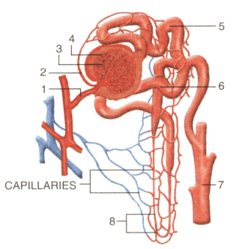
1. Afferent arteriole from renal artery;
2. Efferent arteriole
3. Bowman's capsule,
4. Glomerulus;
5. Proximal convoluted tubule with blood capillaries;
6. Distal convoluted tubule with blood capillaries;
7. Collecting tubule;
8. U - shaped loop of Henle.
Study the diagram and answer the questions that follow:
Which structure contains the lowest concentration of urea?

1. Afferent arteriole from renal artery;
2. Efferent arteriole
3. Bowman's capsule,
4. Glomerulus;
5. Proximal convoluted tubule with blood capillaries;
6. Distal convoluted tubule with blood capillaries;
7. Collecting tubule;
8. U - shaped loop of Henle.
Which structure contains the lowest concentration of urea?

Important Questions on The Excretory System
The following diagram represents a mammalian kidney tubule (nephron) and its blood supply.
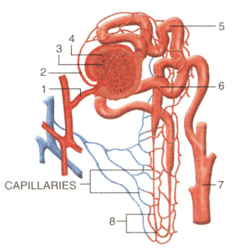
Parts indicated by the guidelines 1 to 8 are as follows :
1. Afferent arteriole from the renal artery;
2. Efferent arteriole
3. Bowman's capsule,
4. Glomerulus;
5. Proximal convoluted tubule with blood capillaries;
6. Distal convoluted tubule with blood capillaries;
7. Collecting tubule;
8. U - shaped loop of Henle.
Study the diagram and answer the questions that follow:
Which structure contains the highest concentration of urea?
The following diagram represents a mammalian kidney tubule (nephron) and its blood supply.
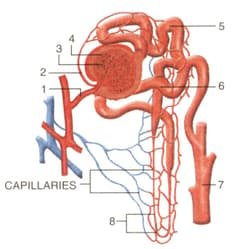
Parts indicated by the guidelines 1 to 8 are as follows :
1. Afferent arteriole from the renal artery;
2. Efferent arteriole
3. Bowman's capsule,
4. Glomerulus;
5. Proximal convoluted tubule with blood capillaries;
6. Distal convoluted tubule with blood capillaries;
7. Collecting tubule;
8. U - shaped loop of Henle.
Study the diagram and answer the questions that follow:
Which structure (normally) contains the lowest concentration of glucose?
The following diagram represents a mammalian kidney tubule (nephron) and its blood supply.
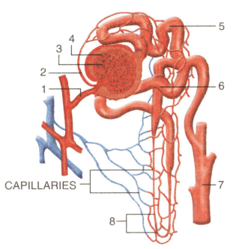
Parts indicated by the guidelines 1 to 8 are as follows :
1. Afferent arteriole from the renal artery;
2. Efferent arteriole
3. Bowman's capsule,
4. Glomerulus;
5. Proximal convoluted tubule with blood capillaries;
6. Distal convoluted tubule with blood capillaries;
7. Collecting tubule;
8. U - shaped loop of Henle.
Study the diagram and answer the questions that follow:
Where is most water reabsorbed?
The following diagram represents a mammalian kidney tubule (nephron) and its blood supply.
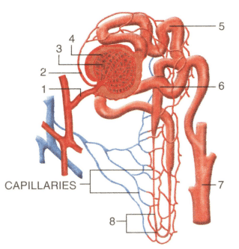
Parts indicated by the guidelines 1 to 8 are as follows :
1. Afferent arteriole from the renal artery;
2. Efferent arteriole
3. Bowman's capsule,
4. Glomerulus;
5. Proximal convoluted tubule with blood capillaries;
6. Distal convoluted tubule with blood capillaries;
7. Collecting tubule;
8. U - shaped loop of Henle.
Study the diagram and answer the questions that follow:
State the reason for the high hydrostatic pressure in the glomerulus.
The following diagram represents a mammalian kidney tubule (nephron) and its blood supply. Parts indicated by the guidelines 1 to 8 are as follows :
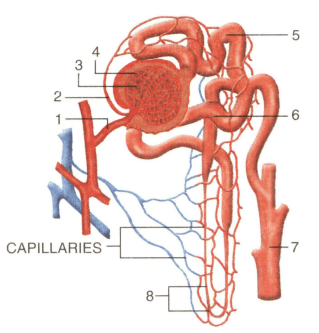
1. Afferent arteriole from the renal artery;
2. Efferent arteriole
3. Bowman's capsule,
4. Glomerulus;
5. Proximal convoluted tubule with blood capillaries;
6. Distal convoluted tubule with blood capillaries;
7. Collecting tubule;
8. U - shaped loop of Henle.
Study the diagram and answer the question that follows:
Name the part of the nephron which lies in the renal medulla.
Given alongside is a simplified diagram of the human kidney cut open longitudinally. Answer the question that follows.
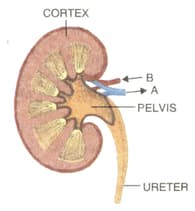
Define excretion.
Given alongside is a simplified diagram of the human kidney cut open longitudinally. Answer the questions that follow.
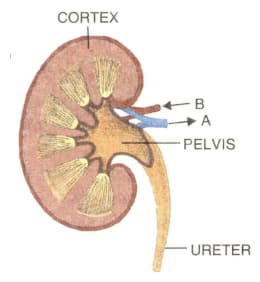
Why does the cortex of the kidney show a dotted appearance?
Given alongside is a simplified diagram of the human kidney cut open longitudinally. Answer the questions that follow.
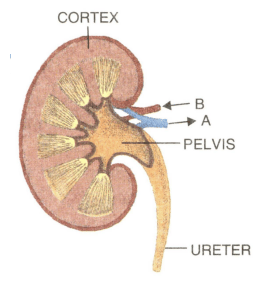
Why does the medulla of the kidney show a striped appearance?
